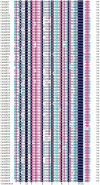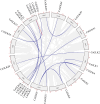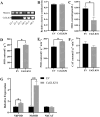Identification and expression analysis of the GLK gene family in tea plant (Camellia sinensis) and a functional study of CsGLK54 under low-temperature stress
- PMID: 38816567
- PMCID: PMC11139860
- DOI: 10.1038/s41598-024-63323-1
Identification and expression analysis of the GLK gene family in tea plant (Camellia sinensis) and a functional study of CsGLK54 under low-temperature stress
Abstract
The Golden2-like (GLK) transcription factor family is a significant group of transcription factors in plantae. The currently available studies have shown that GLK transcription factors have been studied mainly in chloroplast growth and development, with fewer studies in abiotic stress regulation. In this study, all tea plant GLK transcription factors were identified for the first time in tea plants, and genome-wide identification, phylogenetic analysis, and thematic characterization were performed to identify 66 GLK transcription factors in tea plants. These genes are categorized into seven groups, and an amino acid sequence comparison analysis is performed. This study revealed that the structure of GLK genes in tea plants is highly conserved and that these genes are distributed across 14 chromosomes. Collinearity analysis revealed 17 pairs of genes with fragment duplications and one pair of genes with tandem duplications, and the analysis of Ka/Ks ratios indicated that most of the genes underwent negative purifying selection. Analysis of promoter cis-elements revealed that the promoters of tea plant GLK genes contain a large number of cis-acting elements related to phytohormones and stress tolerance. In addition, a large number of genes contain LTR elements, suggesting that tea plant GLK genes are involved in low-temperature stress. qRT‒PCR analysis revealed that the expression of CsGLK17, CsGLK38, CsGLK54, CsGLK11 and CsGLK60 significantly increased and that the expression of CsGLK7 and CsGLK13 decreased in response to low-temperature induction. Taken together, the results of the transcription profile analysis suggested that CsGLK54 may play an important regulatory role under low-temperature stress. The subcellular localization of CsGLK54 was in the nucleus. Furthermore, CsGLK54 positively regulated the transcription levels of the NbPOD and NbSOD genes under low-temperature stress, which led to an increase in POD and SOD enzyme activities and a decrease in MDA content. These findings provide valuable insights into the regulatory mechanism of low-temperature stress in tea plants.
Keywords: Camellia sinensis; Functional validation; GLK family; Genome-wide analysis; Low-temperature stress.
© 2024. The Author(s).
Conflict of interest statement
The authors declare no competing interests.
Figures










Similar articles
-
Genome-wide identification, phylogeny and expression analysis of Hsf gene family in Verbena bonariensis under low-temperature stress.BMC Genomics. 2024 Jul 29;25(1):729. doi: 10.1186/s12864-024-10612-8. BMC Genomics. 2024. PMID: 39075346 Free PMC article.
-
Genome-wide identification of WRKY family genes and their response to abiotic stresses in tea plant (Camellia sinensis).Genes Genomics. 2019 Jan;41(1):17-33. doi: 10.1007/s13258-018-0734-9. Epub 2018 Sep 20. Genes Genomics. 2019. PMID: 30238224
-
Transcriptome-wide identification of Camellia sinensis WRKY transcription factors in response to temperature stress.Mol Genet Genomics. 2016 Feb;291(1):255-69. doi: 10.1007/s00438-015-1107-6. Epub 2015 Aug 26. Mol Genet Genomics. 2016. PMID: 26308611
-
Biosynthesis and the Transcriptional Regulation of Terpenoids in Tea Plants (Camellia sinensis).Int J Mol Sci. 2023 Apr 8;24(8):6937. doi: 10.3390/ijms24086937. Int J Mol Sci. 2023. PMID: 37108101 Free PMC article. Review.
-
Mitigating low-temperature frost damage in Taiwan high-altitude tea cultivation: physiological insight and protective strategies.Planta. 2025 May 4;261(6):125. doi: 10.1007/s00425-025-04704-2. Planta. 2025. PMID: 40319420 Review.
Cited by
-
Genome-Wide Identification of GLK Family Genes in Phoebe bournei and Their Transcriptional Analysis Under Abiotic Stresses.Int J Mol Sci. 2025 Mar 7;26(6):2387. doi: 10.3390/ijms26062387. Int J Mol Sci. 2025. PMID: 40141031 Free PMC article.
References
-
- Hincha DK, Zuther E. Introduction: Plant cold acclimation and freezing tolerance. Plant Cold Acclim. Methods Protoc. 2014;405:1–6. - PubMed
-
- Zhang C, Tian S. Crucial contribution of membrane lipids’ unsaturation to acquisition of chilling-tolerance in peach fruit stored at 0° C. Food Chem. 2009;115(2):405–411. doi: 10.1016/j.foodchem.2008.12.021. - DOI
-
- Wang L-J, Li S-H. Salicylic acid-induced heat or cold tolerance in relation to Ca2+ homeostasis and antioxidant systems in young grape plants. Plant Sci. 2006;170(4):685–694. doi: 10.1016/j.plantsci.2005.09.005. - DOI
-
- Farooq M, Wahid A, Basra SMA. Improving water relations and gas exchange with brassinosteroids in rice under drought stress. J. Agron. Crop Sci. 2009;195(4):262–269. doi: 10.1111/j.1439-037X.2009.00368.x. - DOI
MeSH terms
Substances
LinkOut - more resources
Full Text Sources

